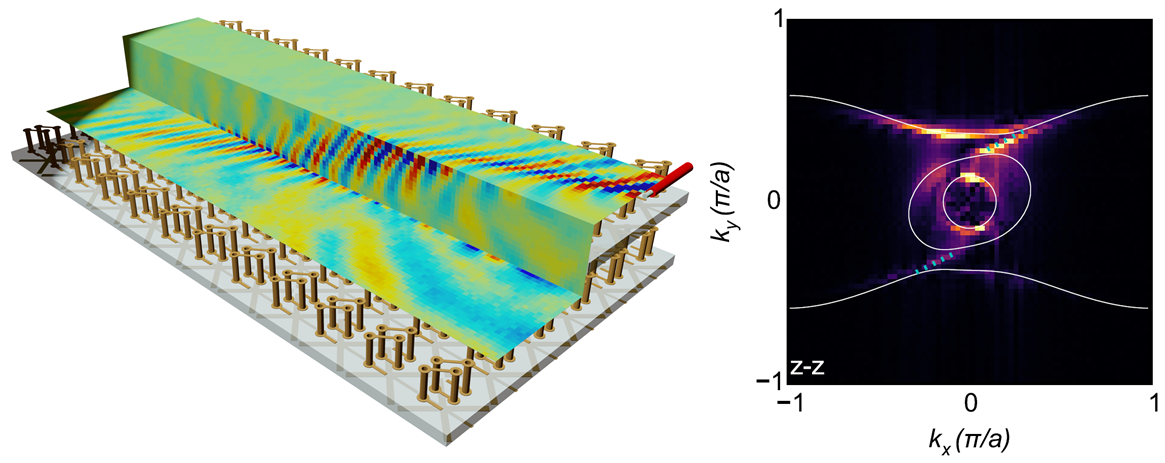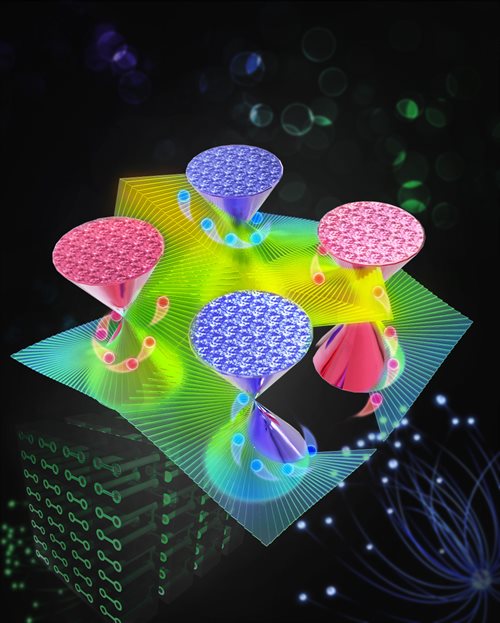Metamaterials
Metamaterials are artificial structures whose electromagnetic properties, represented by the electric permittivity and magnetic permeability, can be engineered by properly designing the building blocks (i.e. the repetitive sub-wavelength unit cell) to achieve extraordinary phenomena not observed easily in nature. This field has revolutionized the way we design and engineer new materials.
The group is currently very active on topological metamaterials and has reported for the first time Fermi arcs in a classical 3D system based on chiral metamaterials (see Figure below). This finding has tremendous implications in fundamental physics and holds promise for scatter-free propagation.
 (Left) Topologically protected surface waves propagating on a step. (Right) Photonic equi-frequency contours containing both bulk and surface states
(Left) Topologically protected surface waves propagating on a step. (Right) Photonic equi-frequency contours containing both bulk and surface states
B. Yang et al., Science 359, 1013 (2018) designed and fabricated an ideal photonic analog of a three-dimensional Weyl system. Angle-resolved transmission and near field scanning measurements revealed four Weyl points at the same energy, as well as the signature helicoidal arcs associated with such an exotic topological system.
 Artwork of an ideal photonic analog of a three-dimensional Weyl system
Artwork of an ideal photonic analog of a three-dimensional Weyl system
Plasmonics
The field of plasmonics is concerned with the science and engineering of optical interaction with the free electrons in metals and semi-conductors. It is meant to bridge the gap between the world of nanoscale electronics and microscale photonics, but it also holds promise in spectroscopy, imaging, quantum physics, nonlinearities, etc.
The group interest in plasmonics is in nanoantennas for harmonic generation and ultra-wideband spectroscopy.
 From left to right: Multi-frequency logperiodic antenna for broadband surface-enhanced spectroscopy (Fluorescence, SERS and SEIRA), hybrid metallo-dielectric nanoantenna for boosted third-harmonic generation, and conformal transformation for analytical description of complex nanoantennas
From left to right: Multi-frequency logperiodic antenna for broadband surface-enhanced spectroscopy (Fluorescence, SERS and SEIRA), hybrid metallo-dielectric nanoantenna for boosted third-harmonic generation, and conformal transformation for analytical description of complex nanoantennas
Terahertz
The terahertz frequency range (ca. 0.3 - 10 THz, i.e., λ = 30 μm - 1 mm) is particularly rich in spectral fingerprints. This includes low energy excitations in electronic materials, low-frequency vibrational modes of condensed phase media, and vibration and rotational transitions in molecules. This region of the spectrum has been less explored than others until recently, due to the lack of efficient and compact THz sources and detectors. THz technology promises significant applications on the areas of security (driven by the global concern of personal screening in public places), medical imaging and high-speed communication.
 Electromagnetic spectrum
Electromagnetic spectrum
The group activity in this field is intertwined with the metamaterials and plasmonics research themes and encompasses two disciplines:
- Modelling, design and measurement of frequency selective surfaces, metasurfaces and metamaterials for quasi-optical mesh filters, highly-confined surface waves, beam-shaping, etc.
 Example of metamaterial lenses, metasurfaces and leaky-wave antennas operating at millimetre-wave and THz frequencies
Example of metamaterial lenses, metasurfaces and leaky-wave antennas operating at millimetre-wave and THz frequencies
- Near-field time-domain microscopy for device (e.g. waveguides) characterization and for the investigation of sub-wavelength particles.
 Figure 5 (a) Sketch of a dielectric-lined waveguide. (b) Experimental frequency-time spectrograms of THz pulses (electric field spectral density) propagating in the PS- (left) and Teflon-lined waveguide (right). (c) Field distribution |Ex|2 of the dominant HE11 mode.
Figure 5 (a) Sketch of a dielectric-lined waveguide. (b) Experimental frequency-time spectrograms of THz pulses (electric field spectral density) propagating in the PS- (left) and Teflon-lined waveguide (right). (c) Field distribution |Ex|2 of the dominant HE11 mode.